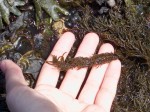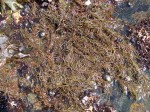| Domain | Eukarya |
| Kingdom | Protoctista |
| Division | Phaeophyta (Brown algae) |
| Class | Phaeophyceae |
| Order | Chordariales |
| Family | Chordariaceae |
| Genus | Analipus |
| Species | japonicus (Harvey) Wynne |
| Common Name: | thickly leaved rockweed |
- A. japonicus in author’s hand
- Analipus japonicus in tide pool
Description: This plant has one or more erect axes arising from a common conspicuous, lobed, encrusting holdfast. The erect portion has a percurrent cylindrical axis, up to 30 cm. high, clothed on all sides with short cylindrical to flattened branchlets up to 3 cm. long; light tan to dark brown in colour.
Habitat: On rocks in the middle and lower intertidal zones.
Pacific Coast Distribution: Bering Sea to California, (Robert Scagel, 1972)
General Characteristics
Analipus japonicus is found in the upper intertidal area frequently on rocks exposed to moderately heavy surf. This brown alga possesses a thallus of light brown color that supports branches up to 35 cm tall. Until recently, the species has been considered to be rare as it was represented by only two or three patches at Race Rocks. It is now becoming more abundant,(2002) on both the western shelf near peg 6 and the north-eastern corner near peg 15.
Reproduction Patterns
Development of the brown alga Analipus japonicus exhibits a pronounced seasonal pattern in many regions of the world. In winter and spring, this alga is found only as prostrate crusts; erect axes develop during the summer and fall. Reproduction is chiefly asexual and takes place from July to November. Unilocular sporangiate plants occur very rarely only in June and July. Plants bearing plurilocular sporangia are abundant from July to November.
Pharmaceutical Uses
In a study by various professors at the Sung Kyun Kwan University, there is a report of the results of a screening of 89 seaweeds collected from British Columbia, Canada, and Korea for antiviral activity. Various concentrations of methanol extracts of dried algae were tested against 100 plaque-forming units of herpes simplex virus type 1 and Sindbis virus in Vero cell monolayers. With reference to Analipus japonicus, it was the most potent anti-herpes species, according to the experimental results.
References:
http://www.usfca.edu/fac-staff/chienp/division%20phaeophyta.html
Biologiya Morya, Vladivostok, 2000, vol. 26, no. 6, pp. 426-429
http://www.skku.ac.kr/~ecology/professor/abstract/biological.html
This file was provided as part of a collaborative effort by the students, faculty, staff and volunteers of Lester B. Pearson College by Paolo Danese 2002 (PC yr 28)

